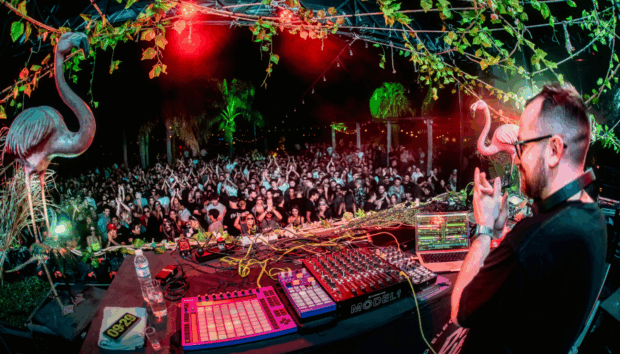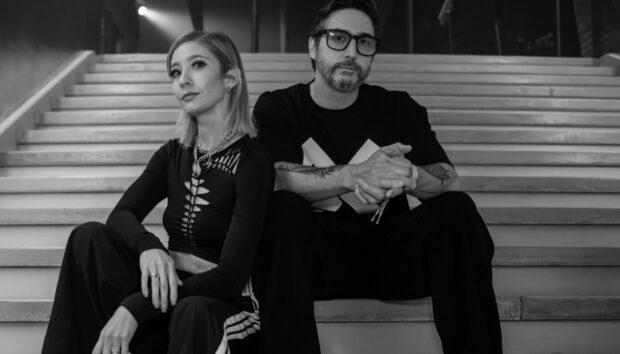
The Chennai KM Music Conservatory in India recently put together a Maschine Ensemble featuring 15 performers, directed by Yash Pathak, and lead by Academic Coordinator Adam Greig. Having performed throughout India, paying tribute to the music school’s legendary founder A. R. Rahman, Native Instruments spoke to the musicians behind the ambitious project to find out how it all came together, and more importantly, how it all works.
Classically trained pianist and computer scientist Adam Greig personifies the forward-thinking philosophy of Chennai’s KM Music Conservatory, where he’s held the post of Academic Coordinator since 2011. Founded in 2008 by legendary Indian movie composer and producer, A. R. Rahman – best known internationally for his Oscar-winning score for Slumdog Millionaire and its spin-off single, ‘Jai Ho’ – KM Music Conservatory is a lavishly equipped, purpose-built facility offering an extensive curriculum of music and music technology courses, and staffed by a roster of highly experienced musicians and educators. Putting equal emphasis on traditional instrumental training and the development of studio-based production skills, it houses a diverse range of faculties and groups, among the most exciting and individual of which is the KM Maschine Ensemble. A band of 15 MASCHINE musicians, coming together as a cohesive finger-drumming whole, this unique performance outfit was formed after Native Instruments donated a number of MASCHINE units to KMMC, as part of the Native Instruments India Tour 2017, organized by local distributor ProMusicals.

“With the arrival of the Maschines, it was a great chance to see the visual and aural impact of having so many of them together in an orchestral setup,” says Adam. “Yash had the most experience with Maschine and had previously done videos of multi- Maschine works, so he was ideal to lead it.”
Yash is professional percussionist and producer, and KM Music Conservatory alumnus Yash Pathak, who directs the Maschine Ensemble. “I already had some experience using four MASCHINEs simultaneously in my setup at concerts for A.R. Rahman,” he explains. “Adam asked me to come up with the KM Maschine Ensemble using the 20 Maschines we had in the institute, in order to provide the students with a platform to learn live studio production performance skills with a practical and theoretical approach. All the students involved come from a variety of professional backgrounds – sound engineering, singing, songwriting, guitar, etc.”
First steps
The Ensemble‘s inaugural performance at the KM Music Conservatory was a live remix/mashup of A. R. Rahman’s seminal soundtrack to the 1999 hit Bollywood movie Taal, put together by Yash. “I wanted to pay tribute to A.R. Rahman in a unique way using the latest music technology,” he says. “I chose the movie album Taal, directed by Rahman, which is considered the greatest Bollywood soundtrack of all time, and still seen as fresh and modern.”
The pool of sounds Yash drew on for his reworking of Taal comprised of synthesized tones from the MASSIVE and PRISM synths, plus “a mixture of my original samples, NI libraries and Expansion sounds, and samples provided by ensemble members.” Positioned at the centre of the ensemble, Yash himself runs the ‘master’ sequences that guide the performance, triggers live phrases and sequences using three MASCHINEs – STUDIO, MIKRO and JAM – and picks up a mic at various points to throw in live vocals. Currently, his is the only MASCHINE in ‘play’ mode, as the other 14 members perform their parts entirely live using the MASCHINE pads. “I did the initial composition, production and mixing for the track, then we created the required groups, sounds and FX individually, to suit the strengths of each ensemble member,” he describes. “To start with, I had to teach them the very basics of the software and the hardware, and that’s the reason I’m the only one in play mode right now. In the future, I want all 15 people to be in play mode, but we’re not even four months old at this point. I’m really working hard towards that, though. “During the performance,” he continues, “I give a click and cues to the group through a separate output, and make sure that everyone is aware of their parts.”
Yash’s stage setup also incorporates a single tabla, which he records and loops on the fly as part of the performance, adding an organic instrumental angle and another layer of visual interest. Steeped in tradition and technically complex, tablas are not an instrument to be trifled with, and fitting one into the overtly electronic setting of the Maschine Ensemble wasn’t straightforward. “When we select a tabla, we have to find the right tuning, first of all, and different tablas have different textures, even when they’re tuned the same,” Yash reveals. “We’re allowed to use a dominant tuned tabla, so in the Taal track, the tabla is tuned to the fifth of the tonic and not the tonic – the tonic of Taal is G, but my tabla is tuned to D. The arrangement is bass- and synth-heavy, and the tabla has to cut through, so we have to find the right texture for it. Even in the same octave, we have a lot of options.
“Then, in terms of the processing, I roll off all the low end, and add a lot of presence and just a bit of plate reverb, and that’s about it. The mixing process isn’t at all complicated – I don’t use extraordinary plug-ins or anything on the tabla. It’s just the traditional part of it that takes a lot of time: the tuning and finding the right instrument for the arrangement.”
Ensemble assemble!
The second outing for the Maschine Ensemble’s Taal mashup was at the IndiEarth XChange music and media trade show. It was the first time Adam had seen the group in action, and by then, Yash had developed and refined the piece further, adding a saxophonist for more live sampling action. “The first thing that strikes you is the very visual nature of the ensemble,” Adam recalls, “how the Maschines shine on stage. Second is the complexity of the arrangement – you question whether it’s happening live or is just pre-recorded. Third, the interaction between electronic and acoustic – between Maschine, voice and sax. Obviously, using A. R.’s music means that it has to be spot on or the audiences will revolt… but the performance I saw had the audience captivated.”
“In our recent performance, we used a saxophonist and sampled the saxophone sounds,” says Yash. “And in the rap section, Indian beatboxing bol samples were recorded and used by one of the students.”
It’s this integration of live instrumentation that most excites Yash when he considers his future plans for the Maschine Ensemble. “I want to fuse it with ethnic Indian instruments, which are becoming extinct and aren’t seen in commercial scenarios at the moment in India,” he states. “Like jal tarang: ceramic bowls, tuned with water. How can we incorporate those types of instruments within the Maschine Ensemble, complimenting both them and the Maschine application?
“We have a sufi ensemble at KM Music Conservatory, also, where we do sufi music, with five or six people playing harmonium together – that’s how I started, in fact. I have a sufi show coming up, where I’ll be using Maschine, so I want to incorporate the sufi ensemble people and use instruments like harmonium and oud with the Maschine Ensemble, keeping within the boundaries of those instruments.”
“One of our percussion teachers is Anantha Krishnan, who’s a mridangam [another technically demanding Indian drum] maestro, a disciple of Zakir Hussain,” he adds. “We’ve yet to figure out how we can collaborate with him. How can we bring his Carnatic South-Indian mridangam skills to the ensemble? We can do all of this once we have one set of students who are very fast with the software and hardware, basically.”
Adam is equally excited by the potential for mixing the Maschine Ensemble up with KM Music Conservatory’s more high-tech musical outlets. “I’m hopeful that the ensemble will start to break down the preconceived boundaries of what electronic music is and the potential of new digital instruments,” he says. “I foresee more interactions between the Maschine Ensemble and some of our digital instrument ensembles, like the ROLI Seaboard, to create fantastic audience experiences in a range of genres including more traditional western classical.”
The future for the ensemble is clearly bright, then, but there’s more to all this than just the intriguing artistic proposition at its core. From Yash’s perspective, the Maschine Ensemble also presents a valuable opportunity to reintroduce millennial and post-millennial musicians to traditional instrumentation, wherever in the world it might originate from. “We need to make sure that the new generation of kids, who think that getting a Maschine, with its colorful lights, is going to make making music easier, realize how important it is to know the acoustic instruments like the tabla, or fundamental music theory, or piano, or whatever,” he asserts. “In the Taal track, I start with my tabla sampling, then I forget the tabla and go to Maschine – I start with the acoustic instrument and then jump into the Maschine world. It’s so important to be linked to the acoustic instruments, not just music technology.
“Maschine helps us take our acoustic knowledge to the next level, but you need that acoustic knowledge in the first place, and the knowledge of harmony and melody, and composition and arrangement,” he concludes. “Without that, Maschine is only a groovebox.”















